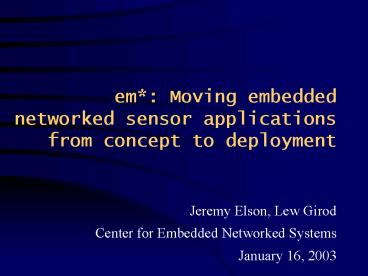em: Moving embedded networked sensor applications from concept to deployment - PowerPoint PPT Presentation
1 / 11
Title:
em: Moving embedded networked sensor applications from concept to deployment
Description:
EMULATOR/SIMULATOR CONTROLLER. Simulated Node 1. Radio. Topology Discovery. Collaborative Sensor ... Emulator (with real motes) in another couple of weeks... – PowerPoint PPT presentation
Number of Views:17
Avg rating:3.0/5.0
Title: em: Moving embedded networked sensor applications from concept to deployment
1
em Moving embedded networked sensor
applicationsfrom concept to deployment
- Jeremy Elson, Lew Girod
- Center for Embedded Networked Systems
- January 16, 2003
2
Fundamental Problems
- We are trying to build systems that meet global
performance criteria - Design evaluation must use a global view
BUT...
- The systems are inherently distributed and have a
strictly local view. - In a deployed system, we cant iterate on design.
There is no way to know if using the discarded
information would have changed the outcome.
3
Fundamental Problems
- Reuse of proven algorithms (and code) is very
important, even for normal software - Given the difficulty of instrumenting our fielded
systems, reuse becomes critical
BUT...
- Domain and application knowledge is needed at
many layers.
How do we create reusable components? How do we
verify components that we change?
4
Hardware
1. Fine Grained decomposition/reuse 2. No
strict layer boundaries
5
The em Strategy
- Fine-Grained Decomposition
- Individual modules (processes) with well-defined
and standardized interfaces - Can be debugged individually, interchanged (e.g.,
routing, ranging), run-time configured - No strict layering
- The processes have much more complex (DAG)
dependencies - Makes it easier to isolate the pieces that are
domain-specific the application layer can
connect to things deep within parts of the stack - Event-based reactive to changes
6
In the real system, each node is autonomous they
communicate via the real environment
. . .
Problem deploying and debugging is a big mess
7
Can we simulate?
- Simulations have been used extensively in
sensornets (ns, ParSec/GlomoSim, custom) - But how do you deploy NS code?
- Its too easy to make unrealistic assumptions
- Recent trend run-real-code simulations
- Forces you to think through the real issues
- Easily move between simulation and reality
- Simulator becomes very useful as a
pre-deployment tool, not just for paper-writing
8
In the simulator, the real software runs in
a synthetic environment (radio, sensors,
acoustics)
. . .
Very Simple Radio Channel Model
Very Simple Acoustic Channel Model
EMULATOR/SIMULATOR CONTROLLER
9
In the hybrid, the real software runs
centrally, interfaced to hardware distributed in
the real world.
. . .
EMULATOR/SIMULATOR CONTROLLER
Radio
Radio
10
So what is em exactly?
- A standard set of useful sensornet services
- Radio device drivers, neighbor discovery, time
sync, routing, flooding, acoustic ranging... - A framework for implementing new services or apps
that fit into the stack - Control programs run an autonomous system, or n
copies with a channel sim - Visualization easy to plug in your code
- A library of useful but mundane functions
- Get your node ID, timers, logging
11
Summary
- This stuff will be really cool...
- ...but pieces dont quite exist yet
- Basic services (send/receive packets, neighbor
discovery, flooding, timesync, simulator) ready
this week - Visualization next week
- Emulator (with real motes) in another couple of
weeks... But the beauty is that you can develop
code today in the sim - Classmates and labmates will then be developing
in parallel































